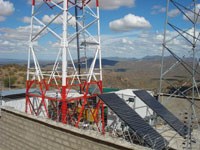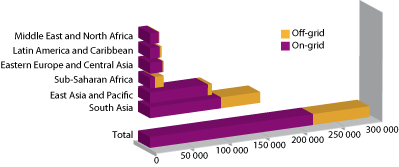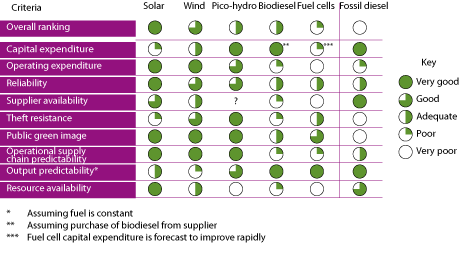  Winafrique
Winafrique
|
Green power for mobile networks
It has been estimated that about
a third of the world’s population have unreliable power supplies
—or no access to electricity at all. In order for them to be
able to take advantage of mobile communications, base stations
have to be powered by such means as diesel-driven generators.
However, as diesel prices rise and network infrastructure
spreads to more remote areas, other alternatives are required,
not only in order to save money, but also to help combat climate
change.
The GSM Association (GSMA) launched in
September 2008 a programme called
Green Power for Mobile to promote the use of renewable
energy sources by the mobile phone industry. Its goal is to see
118 000 new and existing off-grid base stations powered in this
way by 2012. It says that this would save up to 2.5 billion
litres of diesel a year and cut annual greenhouse-gas emissions
by up to 6.8 million tonnes. It would also give a boost to the
provision of mobile phone services in places that cannot yet use
them.
Assessing the situation
|
Figure 1 — Annual growth in base
transceiver station sites in developing regions over the period
2007–2012
|
|

Source: GSMA. |
GSMA carried out a survey of operators,
vendors, green power suppliers and financiers to evaluate the
market and technical landscape. Its report*, published in March
2009, says that of the estimated 300 000 base transceiver
stations that will be built in developing countries up to the
end of 2012, some 75 000 will not be connected to electricity
supply grids (see Figure 1). It
points out that extending the grid to such sites would be
enormously expensive. Reliability is another problem, in both
rural and urban areas. For example, in rural India, electricity
supplies might be cut off for up to 14 hours a day, according to
the survey.
|
Figure 2 — The viability of green power solutions
|
|

Source: GSMA. |
To power base stations that are not on
the grid, diesel fuel has often been chosen for electricity
generators. However, the price of diesel has risen
substantially in many places, as well as the cost of delivering
the fuel to remote locations.
Sustainable sources of power
As alternatives to diesel, GSMA analysed
the viability of other sources of power for mobile base
stations: solar, wind, biodiesel, pico-hydro (very small
hydroelectric systems) and fuel cells (see
Figure 2).
Solar power
There is often an abundance of sunlight
in rural areas of developing countries, and this, together with
the increasing availability of solar equipment and its
relatively low running cost, makes solar power a popular choice
for sites that need up to 2 kW of power. Solar solutions are
less economically attractive for larger sites, the report says,
but it foresees that the price of installing solar power is
likely to fall in the coming years.
Wind
The equipment to trap wind energy is
cheaper than for solar-powered stations that have standard load
requirements. It costs about 10 or 11 US cents per kWh to
produce electricity at small wind-powered stations, according to
a study by the American Wind Energy Association, and this is
projected to drop to 7 US cents within five years. However, wind
power is only viable in such areas as coastal and mountainous
regions, where wind blows sufficiently strongly and frequently.
In other places, hybrid solutions may be used that combine wind
and solar power.
Pico-hydro
Pico-hydro refers to very small
hydroelectric power generators that typically produce up to 10kW
from the energy of streams and rivers. It is a mature technology
for other applications such as rural electrification and has one
of the lowest capital investment requirements of all. But again,
it is applicable only in a limited number of places.
Biodiesel
Biodiesel fuel (derived from vegetable
oils or animal fats) can be used as a direct replacement for
conventional diesel in base station generators, but it is not
necessarily a universal solution. Among the factors that must be
considered are local access to supplies of biodiesel, and how
its production could affect agriculture.
Fuel cells
Fuel cells, or batteries, are mainly
used as back-up electricity supplies for base stations that have
limited power requirements. So far, the commercial viability of
using fuel cells as the prime power source has not been greatly
tested. However, research and development is being undertaken on
the technology, and suppliers have forecast a cost reduction of
30 per cent by 2010, according to GSMA.
Saving money too
Figure 2 shows that it is comparatively
inexpensive to install a diesel-powered generator for a mobile
base station; however, the operating costs in fuel and
maintenance are “high and extremely vulnerable to market
conditions,” the GSMA report says. At present, solar and wind
power solutions require about 50 per cent more capital
investment, but they have much lower running costs. They more
quickly pay for themselves in cases where the site load is below
2 kW. In other situations hybrid systems can be valuable,
combining diesel with green power solutions to reduce
operational costs along with the environmental impact.
|
Table 1 — Total projected off-grid green power base
tranceiver stations by 2012 (dependent on
operator requirement for specific payback
periods) |
|
|
3-year payback
period
|
4-year payback
period
|
5-year payback
period
|
|
Percentage of off-grid
BTS sites viable for green power
|
9%
|
20%
|
30%
|
|
Number of green sites
by 2012
|
53 000
|
118 000
|
176 000
|
|
Reduction of diesel per
year
|
1.1 billion litres
|
2.5 billion litres
|
3.5 billion litres
|
|
Fuel cost savings per
year
|
USD 1.3 billion
|
USD 2.9 billion
|
USD 4.4 billion
|
|
CO2
emission reduction per year
|
3 million tonnes
|
6.8 million tonnes
|
10 million tonnes
|
|
Source: GSMA.
|
If operators look for a three-year
payback on investment, GSMA suggests that 9 per cent of mobile
base stations could be powered by green energy sources by 2012,
saving 3 million tonnes of CO2
emissions each year and USD 1.3 billion in fuel costs (see
Table 1). With a five-year payback period, the figures rise
to 30 per cent of base stations using green power and thereby
saving 10 million tonnes of greenhouse-gas emissions — as well
as USD 4.4 billion in fuel costs. After 2012, GSMA predicts that
“up to 50 per cent of new off-grid base stations in the
developing world will be powered by renewable energy.”
Energy-efficient design
Another aspect of green technology is
improved design that reduces energy consumption. The GSMA survey
shows that manufacturers of telecommunication equipment are
making considerable investments in developing devices that need
less power. ITU’s work is important in this effort, such as in
the energy-efficiency checklist created in 2008 to be used when
developing technical standards.
In addition, major energy savings can be
achieved by designing equipment that can work in temperatures of
up to 45░C without the need for powered air-conditioning systems
to cool it. Instead, temperatures can be moderated by much more
cost-effective solutions such as simple fans, shading, or the
heat sinks provided by thick stone walls.
The need for cooling is a significant
element of the costs of a base station — it can be at least
equivalent to the cost of powering the transmitter itself,
according to the GSMA analysis. Achieving energy efficiency is
thus an important part of creating viable green power solutions,
especially for stations with higher load requirements.
Better and innovative design will help
to reduce the costs of expanding mobile networks into remote
areas that do not have a mains electricity supply. In many
cases, building mobile base stations that use green energy will
not only create economic and environmental benefits; it also
seems likely to become a major means of connecting people to the
information society.
|


